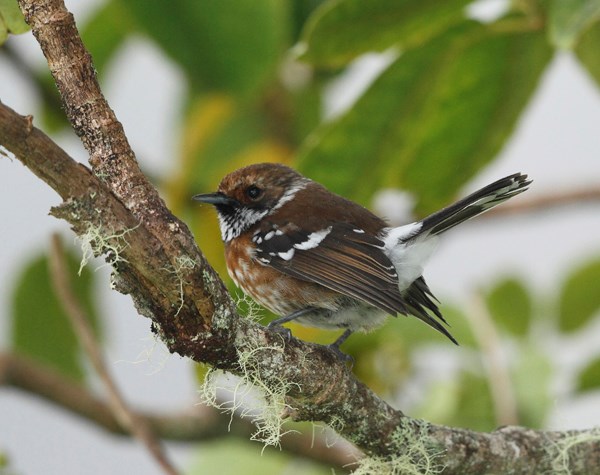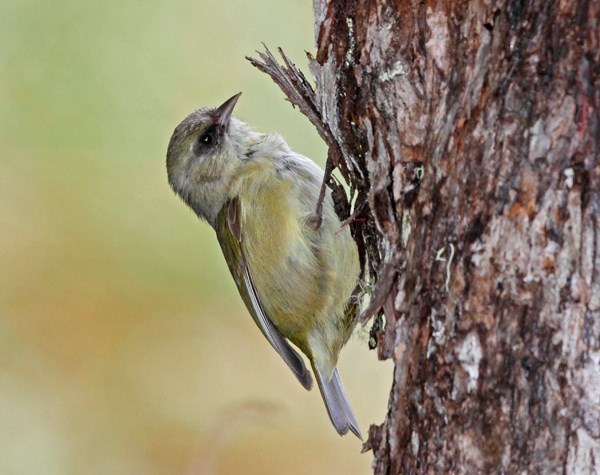
Photo: Jack Jeffrey
ʻApapane
ʻApapane are the most abundant species of the Hawaiian honeycreeper. They are known for their wide-ranging flights in search of localized blooms of endemic ʻōhi‘a lehua, its primary food source. They are abundant in higher elevation forests including along Crater Rim Drive and the Mauna Loa Strip Road, especially when the ʻōhi‘a lehua are in bloom. The ʻapapane has an incredibly diverse array of songs and calls that vary between, and even within, islands. Their bright crimson plumage, black wings and tail, prominent white undertail-coverts and abdomen, and long, decurved bill are distinct characteristics for this species.

Photo: Jack Jeffrey
ʻIʻiwi
The ʻiʻiwi is one of the most spectacular of extant Hawaiian birds, with vermilion plumage, black wings and tail, and a long, decurved bill. In pre-European Hawaiʻi, beautiful feather capes, sometimes containing hundreds of thousands of ʻiʻiwi feathers, were a symbol of power and prestige among native Hawaiians. ‘I‘iwi and ‘apapane are well known for their long flights over the forests in search of flowers of the endemic ʻōhiʻa tree, their primary food source. Typically found only in high-elevation forests of the park above 4,500 feet where mosquitos that transmit avian malaria and avian pox are less common.

Photo: Jack Jeffrey
Hawaiʻi ʻAmakihi
Hawaiʻi ʻamakihi is one of the most common native forest birds, which in recent years has sometimes been found at elevations below 3,500 feet where mosquitos and avian disease transmission are more prevalent. They are nonmigratory and omnivorous, feeding mainly on insects and small arthropods and some nectar.

Photo: Jack Jeffrey
Hawaiʻi ʻElepaio
Hawaiʻi ‘elepaio are active, agile, and versatile flycatchers that occur in high-elevation forests of the park where they glean insects from vegetation in the understory and throughout the forest canopy, and catch insects on the wing. ‘Elepaio were considered ʻaumakua ("guiding spirit") of Hawaiian canoe makers. If an ‘elepaio pecked at a koa tree that had been cut down for canoe-making, it was regarded as unseaworthy and not used.

Photo: Jack Jeffery
ʻŌmaʻo
Also known as the Hawaiian Thrush, ʻōmaʻo occur only on Hawaiʻi Island in montane rain forests above 3,000 feet. Their diet consists primarily of fruits, and supplemented by invertebrates.

Photo: Jack Jeffrey
ʻAkiapōlāʻau
ʻAkiapōlāʻau are an endangered Hawaiian honeycreeper found in high-elevation forests of the Kahuku unit of the park, above the distribution of disease-transmitting mosquitos. Known as the Hawaiian honeycreeper with the "Swiss Army knife beak", the tree-dwelling ‘akiapōlā‘au moves along branches and twigs, pausing inquisitively to tap or probe the bark and epiphytes with its unique bill. Once it detects a hiding caterpiller or spider, the bird excavates the substrate and extracts the prey with its hooked beak.

Photo: Jack Jeffrey
Hawaiʻi ʻĀkepa
The Hawaiʻi ʻākepa is an endangered Hawaiian honeycreeper found in high-elevation forests of the Kahuku unit of the park. They use their odd-shaped bills to pry open endemic ʻōhiʻa lehua buds, small seed pods, and galls in search of insects and spiders.

Photo: Jack Jeffrey
ʻAlawī
The ʻalawī, or Hawaiʻi creeper, is an endangered Hawaiian honeycreeper found in high-elevation forests of the Kahuku unit of the park. An active species, feeding nuthatch-like on branches and tree trunks for insects and spiders but sometimes foraging in foliage.

Photo: Jack Jeffrey
ʻlo
ʻIo are widespread on the Island of Hawaiʻi and regularly seen in the park. They are also known as the Hawaiian hawk.
Last updated: August 17, 2023
